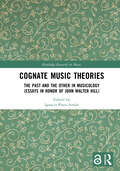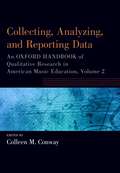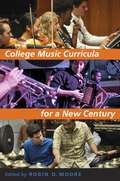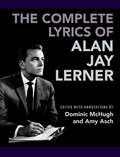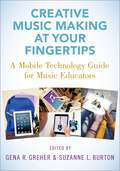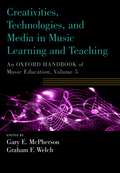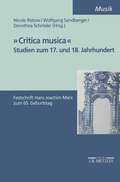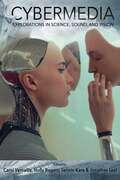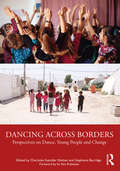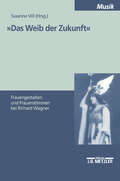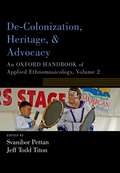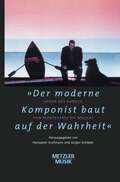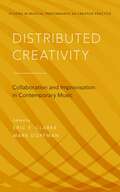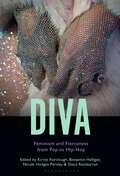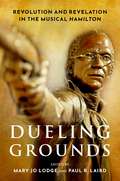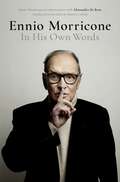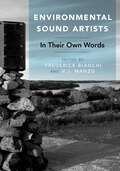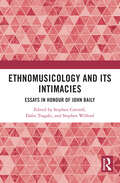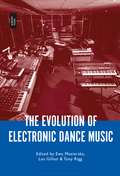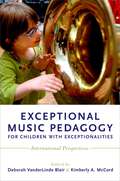- Table View
- List View
Cognate Music Theories: The Past and the Other in Musicology (Essays in Honor of John Walter Hill) (Routledge Research in Music)
This volume explores the possibilities of cognate music theory, a concept introduced by musicologist John Walter Hill to describe culturally and historically situated music theory.Cognate music theories offer a new way of thinking about music theory, music history, and the relationship between insider and outsider perspectives when researchers mediate between their own historical and cultural position, and that of the originators of the music they are studying. With contributions from noted scholars of musicology, music theory, and ethnomusicology, this volume develops a variety of approaches using the cognate music theory framework and shows how this concept enables more nuanced and critical analyses of music in historical context.Addressing topics in music from the seventeenth to nineteenth centuries, this volume will be relevant to musicologists, music theorists, and all researchers interested in reflecting critically on what it means to construct a theory of music.
Collecting, Analyzing and Reporting Data: An Oxford Handbook of Qualitative Research in American Music Education, Volume 2 (Oxford Handbooks)
In a newly updated paperback release, Collecting, Analyzing, and Reporting Data considers an array of strategies for working with qualitative data in American music education. Observations, interviews, focus groups, document analysis and music-making as data reveal unique potential to inform the field of music education. The capabilities of digital technologies to collect and analyze data, as well as the challenges they present, are examined in the context of an increasingly digitized American society. Guidance is provided to the researcher to understand their role and the ethical landscape they navigate. Collecting, Analyzing, and Reporting Data is the second of three paperback volumes derived from the original Oxford Handbook of Qualitative Research in American Music Education, which outlines the history of qualitative research in music education and explores the contemporary use of qualitative approaches in examining issues related to music teaching and learning.
College Music Curricula for a New Century
Critiques and calls for reform have existed for decades within music education, but few publications have offered concrete suggestions as to how things might be done differently. Motivated by a desire to do just that, College Music Curricula for a New Century considers what a more inclusive, dynamic, and socially engaged curriculum of musical study might look like in universities. Editor Robin Moore creates a dialogue among faculty, administrators, and students about what the future of college music instruction should be and how teachers, institutions, and organizations can transition to new paradigms. Including contributions from leading figures in ethnomusicology, music education, theory/composition, professional performance, and administration, College Music Curricula for a New Century addresses college-level curriculum reform, focusing primarily on performance and music education degrees, and offer ideas and examples for a more inclusive, dynamic, and socially engaged curriculum of applied musical study. This book will appeal to thoughtful faculty looking for direction on how to enact reform, to graduate students with investment in shaping future music curricula, and to administrators who know change is on the horizon and seek wisdom and practical advice for implementing change. College Music Curricula for a New Century reaches far beyond any musical subdiscipline and addresses issues pertinent to all areas of music study.
The Complete Lyrics of Alan Jay Lerner
Alan Jay Lerner wrote the lyrics for some of the most beloved musicals in Broadway and Hollywood history. Most notably, with composer Frederick Loewe he created enduring hits such as My Fair Lady, Gigi, Camelot, and Brigadoon. In The Complete Lyrics of Alan Jay Lerner, editors and annotators Dominic McHugh and Amy Asch bring all of Lerner's lyrics together for the first time, including numerous draft or alternate versions and songs cut from the shows. Compiled from dozens of archival collections, this invaluable resource and authoritative reference includes both Lerner's classic works and numerous discoveries, including his unproduced MGM movie Huckleberry Finn, selections from his college musicals, and lyrics from three different versions of Paint Your Wagon. This collection also includes extensive material from Lerner's two most ambitious musicals: Love Life, to music by Kurt Weill, and 1600 Pennsylvania Avenue, which Lerner wrote with Leonard Bernstein.
Creative Music Making at Your Fingertips: A Mobile Technology Guide for Music Educators
Students are drawn to mobile technologies such as iPads and smartphones because of the sheer endless possibilities of the digital worlds they hold. But how can their potential for stimulating the imagination be effectively used in the music classroom to support students' development of musical thinking? Countering voices that see digital technologies as a threat to traditional forms of music making and music education, this collection explores the many ways in which hand-held devices can be used to promote student learning and provides teachers with guidance on making them a vital presence in their own classrooms. Creative Music Making at Your Fingertips features 11 chapters by music education scholars and practitioners that provide tried-and-true strategies for using mobile devices in a variety of contexts, from general music education to ensembles and from K-12 to college classrooms. Drawing on their own experiences with bringing mobile devices and different music apps into the classroom, contributors show how these technologies can be turned into tools for teaching performance, improvisation, and composition. Their practical advice on how pedagogy and mobile technologies can be aligned to increase students' creative engagement with music and help them realize their musical potential makes this book an invaluable resource for music educators who want to be at the forefront of pedagogical transformations made possible by 21st-century technologies.
Creativities, Technologies, and Media in Music Learning and Teaching: An Oxford Handbook of Music Education, Volume 5 (Oxford Handbooks)
Creativities, Media, and Technology in Music Learning and Teaching is one of five paperback books derived from the foundational two-volume Oxford Handbook of Music Education. Designed for music teachers, students, and scholars of music education, as well as educational administrators and policy makers, this fifth book in the set comprises three complementary sections: musical creativity as practice; music teaching and learning through technology; and the interplay of media, music, and education. The first section reviews notions of musical creativity, examining practice-based perspectives to support and develop understanding of the diverse types of creativity found within music education practice across the globe. In the second section, authors explore the essential role of technology in musical discourse and in various forms of musical learning, even as technology continually evolves and the needs and possibilities continue to rapidly change. The third section provokes readers to assess their own thinking about the transformative changes occurring within the discipline as a result of advances in media, and the increasing infiltration of media into all aspects of life, the classroom, and music making. Contributors Andrew R. Brown, Pamela Burnard, Bernadette Colley, Ian Cross, Rokus de Groot, Steven C. Dillon, Randi Margrethe Eidsaa, David G. Hebert, Evangelos Himonides, Neryl Jeanneret, Ailbhe Kenny, Andrew King, Eleni Lapidaki, Felicity Laurence, Samuel Leong, Bo Wah Leung, Alagi Mbye, Gary E. McPherson, Ross Purves, Tal-Chen Rabinowitch, S. Alex Ruthmann, Eva Sæther, Jonathan Savage, Reza Shayesteh, Petros Stagkos, Matthew D. Thibeault, Evan S. Tobias, Carole Waugh, Graham F. Welch
"Critica Musica" - Studien zum 17. und 18. Jahrhundert: Festschrift Hans Joachim Marx zum 65. Geburtstag
Die Beförderung der historisch-kritischen Musikwissenschaft ist das Anliegen der vorliegenden Festschrift.
Cybermedia: Explorations in Science, Sound, and Vision (New Approaches to Sound, Music, and Media)
We're experiencing a time when digital technologies and advances in artificial intelligence, robotics, and big data are redefining what it means to be human. How do these advancements affect contemporary media and music? This collection traces how media, with a focus on sound and image, engages with these new technologies. It bridges the gap between science and the humanities by pairing humanists' close readings of contemporary media with scientists' discussions of the science and math that inform them. This text includes contributions by established and emerging scholars performing across-the-aisle research on new technologies, exploring topics such as facial and gait recognition; EEG and audiovisual materials; surveillance; and sound and images in relation to questions of sexual identity, race, ethnicity, disability, and class and includes examples from a range of films and TV shows including Blade Runner, Black Mirror, Mr. Robot, Morgan, Ex Machina, and Westworld. Through a variety of critical, theoretical, proprioceptive, and speculative lenses, the collection facilitates interdisciplinary thinking and collaboration and provides readers with ways of responding to these new technologies.
Dancing Across Borders: Perspectives on Dance, Young People and Change
Dancing Across Borders presents formal and non-formal settings of dance education where initiatives in different countries transcend borders: cultural and national borders, subject borders, professional borders and socio-economic borders. It includes chapters featuring different theoretical perspectives on dance and cultural diversity, alongside case narratives that show these perspectives in a specific cultural setting. In this way, each section charts the processes, change and transformation in the lives of young people through dance. Key themes include how student learning is enhanced by cultural diversity, experiential teaching and learning involving social, cross-cultural and personal dimensions. This conceptually aligns with the current UNESCO protocols that accent empathy, creativity, cooperation, collaboration alongside skills- and knowledge-based learning in an endeavour to create civic mindedness and a more harmonious world. This volume is an invaluable resource for teachers, policy makers, artists and scholars interested in pedagogy, choreography, community dance practice, social and cultural studies, aesthetics and interdisciplinary arts. By understanding the impact of these cross-border collaborative initiatives, readers can better understand, promote and create new ways of thinking and working in the field of dance education for the benefit of new generations.
Dancing Across Borders: Perspectives on Dance, Young People and Change
Dancing Across Borders presents formal and non-formal settings of dance education where initiatives in different countries transcend borders: cultural and national borders, subject borders, professional borders and socio-economic borders. It includes chapters featuring different theoretical perspectives on dance and cultural diversity, alongside case narratives that show these perspectives in a specific cultural setting. In this way, each section charts the processes, change and transformation in the lives of young people through dance. Key themes include how student learning is enhanced by cultural diversity, experiential teaching and learning involving social, cross-cultural and personal dimensions. This conceptually aligns with the current UNESCO protocols that accent empathy, creativity, cooperation, collaboration alongside skills- and knowledge-based learning in an endeavour to create civic mindedness and a more harmonious world. This volume is an invaluable resource for teachers, policy makers, artists and scholars interested in pedagogy, choreography, community dance practice, social and cultural studies, aesthetics and interdisciplinary arts. By understanding the impact of these cross-border collaborative initiatives, readers can better understand, promote and create new ways of thinking and working in the field of dance education for the benefit of new generations.
"Das Weib der Zukunft": Frauengestalten und Frauenstimmen bei Richard Wagner. Internationales Symposium zu den Bayreuther Festspielen 9.-11. 8. 1997
»Das Weib der Zukunft« nannte Richard Wagner jene Vision einer Frau, in deren Liebe die rastlose Suche des fliegenden Holländers, Ahasveros, Odysseus und Columbus Erfüllung finden kann: Die Triebkräfte des modernen Geistes, die Neugier und die Suche nach Wissen, Erkenntnis, Aufklärung und Abenteuer können Frieden finden im Verstehen jenes »ersehnten, geahnten, unendlich weiblichen Weibes«. 1851 hielt Wagner noch die Aufopferungsbereitschaft der Senta für die wesentlichste Eigenschaft seines Idealtyps, doch in seinen späteren Werken gestaltet er Bilder von kraftvollen, aktiven, und die Geschichte der Welt wesentlich mitprägenden Heldinnen, die das Selbstbild der Frauen im späten 19. und im 20. Jahrhundert stark beeinflußt haben. Mit der hochdramatischen »Sing-Schauspielerin« hat Wagner ein neues Stimmfach geschaffen und einen neuen Frauentypus auf die Musiktheaterbühne gebracht. Das interdisziplinäre Symposium behandelte Wagners Vorbilder in Mythologie, Kunst und Literatur wie auch seine Philosphie vom »Weiblichen im Menschlichen«.
De-Colonization, Heritage, and Advocacy: An Oxford Handbook of Applied Ethnomusicology, Volume 2 (Oxford Handbooks)
The nine ethnomusicologists who contributed to this volume present a diverse range of views, approaches, and methodologies that address indigenous peoples, immigrants, and marginalized communities. Discussing participatory action research, social justice, empowerment, and critical race theory in relation to ethnomusicology, De-Colonization, Heritage, and Advocacy is the second of three paperback volumes derived from the original Oxford Handbook of Applied Ethnomusicology. The Handbook can be understood as an applied ethnomusicology project: as a medium of getting to know the thoughts and experiences of global ethnomusicologists, of enriching general knowledge and understanding about ethnomusicologies and applied ethnomusicologies in various parts of the world, and of inspiring readers to put the accumulated knowledge, understanding, and skills into good use for the betterment of our world.
"Der moderne Komponist baut auf der Wahrheit": Opern des Barock von Monteverdi bis Mozart
Die Barock-Oper - lange Zeit von den Bühnen verbannt, erlebt inzwischen wieder eine neue Blüte. Von der Geburt des Genres um 1600 in Florentiner Adels- und Gelehrtenkreisen bis zu Mozarts "Zauberflöte" aus dem Jahr 1791 porträtiert der Band die interessantesten barocken Opern und zentrale Werke. Der Bogen reicht von Monteverdi über Purcell und Händel bis zu Mozart, bei dem die barocke Form ihre volle Pracht entfaltet. Namhafte Opernkenner liefern spannende Beiträge zu den 16 wichtigsten Musikdramen.
"Die Wirklichkeit erfinden ist besser": Oper des 19.Jahrhunderts von Beethoven bis Verdi
Von Beethoven bis Verdi. Der Band beleuchtet anhand wichtiger Komponisten und 26 zentraler Werke die Entwicklung der Operngeschichte im 19. Jahrhundert. Dabei erhält der Leser facettenreiche Einblicke in Struktur, Dramaturgie und Musik der behandelten Opern. Eine individuelle Operngeschichte mit erhellendem Blick auf die Hauptwerke des Musiktheaters im 19. Jahrhundert.
Distortion in Music Production: The Soul of Sonics (Perspectives on Music Production)
Distortion in Music Production offers a range of valuable perspectives on how engineers and producers use distortion and colouration as production tools. Readers are provided with detailed and informed considerations on the use of non-linear signal processing, by authors working in a wide array of academic, creative, and professional contexts. Including comprehensive coverage of the process, as well as historical perspectives and future innovations, this book features interviews and contributions from academics and industry practitioners. Distortion in Music Production also explores ways in which music producers can implement the process in their work and how the effect can be used and abused through examination from technical, practical, and musicological perspectives. This text is one of the first to offer an extensive investigation of distortion in music production and constitutes essential reading for students and practitioners working in music production.
Distributed Creativity: Collaboration and Improvisation in Contemporary Music (Studies in Musical Perf as Creative Prac)
Creative practice in music, particularly in traditional concert culture, is commonly understood in terms of a rather stark division of labour between composer and performer. But this overlooks the distributed and interactive nature of the creative processes on which so much contemporary music depends. The incorporation of two features-improvisation and collaboration-into much contemporary music suggests that the received view of the relationship between composition and performance requires reassessment. Improvisation and collaborative working practices blur the composition/performance divide and, in doing so, provide important new perspectives on the forms of distributed creativity that play a central part in much contemporary music. Distributed Creativity: Collaboration and Improvisation in Contemporary Music explores the different ways in which collaboration and improvisation enable and constrain creative processes. Thirteen chapters and twelve shorter Interventions offer a range of perspectives on distributed creativity in music, on composer/performer collaborations and on contemporary improvisation practices. The chapters provide substantial discussions of a variety of conceptual frameworks and particular projects, while the Interventions present more informal contributions from a variety of practitioners (performers, composers, improvisers), giving insights into the pleasures and perils of working creatively in collaborative and improvised ways.
Diva: Feminism and Fierceness from Pop to Hip-Hop
The diva – a central figure in the landscape of contemporary popular culture: gossip-generating, scandal-courting, paparazzi-stalked. And yet the diva is at the epicentre of creative endeavours that resonate with contemporary feminist ideas, kick back against diminished social expectations, boldly call-out casual sexism and industry misogyny and, in terms of hip-hop, explores intersectional oppressions and unapologetically celebrates non-white cultural heritages. Diva beats and grooves echo across culture and politics in the West: from the borough to the White House, from arena concerts to nightclubs, from social media to social activism, from #MeToo to Black Lives Matter.Diva: Feminism and Fierceness from Pop to Hip-Hop addresses the diva phenomenon and its origins: its identity politics and LGBTQ+ components; its creativity and interventions in areas of popular culture (music, and beyond); its saints and sinners and controversies old and new; and its oppositions to, and recuperations by, the establishment; and its shifts from third to fourth waves of feminism. This co-edited collection brings together an international array of writers – from new voices to established names. The collection scopes the rise to power of the diva (looking to Mariah Carey, Whitney Houston, Dolly Parton, Grace Jones, and Aaliyah), then turns to contemporary diva figures and their work (with Beyoncé, Amuro Namie, Janelle Monáe, Cardi B, Megan Thee Stallion, Shakira, Jennifer Lopez, and Nicki Minaj), and concludes by considering the presence of the diva in wider cultures, in terms of gallery curation, theatre productions, and stand-up comedy.
Dueling Grounds: Revolution and Revelation in the Musical Hamilton
Hamilton opened on Broadway in 2015 and quickly became one of the hottest tickets the industry has ever seen. Lin-Manuel Miranda - who wrote the book, lyrics, and music, and created the title role - adapted the show from Ron Chernow's biography Alexander Hamilton. Although it seems an unlikely source for a Broadway musical, Miranda found a liminal space where the life that Hamilton led and the issues that he confronted came alive more than two centuries later while also commenting on contemporary life in the United States and how we view our nation's history. With a score largely based on rap and drawing on other aspects of hip-hop culture, and staged with actors of color playing the white Founding Fathers, Hamilton has much to say about race in the United States today and in our past, but at the same time it leaves important things insufficiently explained, such as the role of women and people of color in Hamilton's time. Dueling Grounds: Revolution and Revelation in the Musical Hamilton is a volume that combines the work of theater scholars and practitioners, musicologists, and scholars in such fields as ethnomusicology, history, gender studies, and economics in a multi-faceted approach to the show's varied uses of liminality, looking at its creation, casting philosophy, dance and movement, costuming, staging, direction, lyrics, music, marketing, and how aspects of race, gender, and class fit into the show and its production. Demonstrating that there is much to celebrate, as well as challenging issues to confront concerning Hamilton, Dueling Grounds is an uncompromising look at one of the most important musicals of the century.
Encyclopedia of African American Music [3 volumes]: [3 volumes]
African Americans' historical roots are encapsulated in the lyrics, melodies, and rhythms of their music. In the 18th and 19th centuries, African slaves, longing for emancipation, expressed their hopes and dreams through spirituals. Inspired by African civilization and culture, as well as religion, art, literature, and social issues, this influential, joyous, tragic, uplifting, challenging, and enduring music evolved into many diverse genres, including jazz, blues, rock and roll, soul, swing, and hip hop. Providing a lyrical history of our nation, this groundbreaking encyclopedia, the first of its kind, showcases all facets of African American music including folk, religious, concert and popular styles. Over 500 in-depth entries by more than 100 scholars on a vast range of topics such as genres, styles, individuals, groups, and collectives as well as historical topics such as music of the Harlem Renaissance, the Black Arts Movement, the Civil Rights Movement, and numerous others. Offering balanced representation of key individuals, groups, and ensembles associated with diverse religious beliefs, political affiliations, and other perspectives not usually approached, this indispensable reference illuminates the profound role that African American music has played in American cultural history.Editors Price, Kernodle, and Maxile provide balanced representation of various individuals, groups and ensembles associated with diverse religious beliefs, political affiliations, and perspectives. Also highlighted are the major record labels, institutions of higher learning, and various cultural venues that have had a tremendous impact on the development and preservation of African American music. Among the featured: Motown Records, Black Swan Records, Fisk University, Gospel Music Workshop of America, The Cotton Club, Center for Black Music Research, and more. With a broad scope, substantial entries, current coverage, and special attention to historical, political, and social contexts, this encyclopedia is designed specifically for high school and undergraduate students. Academic and public libraries will treasure this resource as an incomparable guide to our nation's African American heritage.
Ennio Morricone: In His Own Words
Master composer Ennio Morricone's scores go hand-in-hand with the idea of the Western film. Often considered the world's greatest living film composer, and most widely known for his innovative scores to The Good, the Bad, and the Ugly and the other Sergio Leone's movies, The Mission, Cinema Paradiso and more recently, The Hateful Eight, Morricone has spent the past 60 years reinventing the sound of cinema. In Ennio Morricone: In His Own Words, composers Ennio Morricone and Alessandro De Rosa present a years-long discussion of life, music, and the marvelous and unpredictable ways that the two come into contact with and influence each other. The result is what Morricone himself defines: "beyond a shadow of a doubt the best book ever written about me, the most authentic, the most detailed and well curated. The truest." Opening for the first time the door of his creative laboratory, Morricone offers an exhaustive and rich account of his life, from his early years of study to genre-defining collaborations with the most important Italian and international directors, including Leone, Bertolucci, Pasolini, Argento, Tornatore, Malick, Carpenter, Stone, Nichols, De Palma, Beatty, Levinson, Almodóvar, Polanski, and Tarantino. In the process, Morricone unveils the curious relationship that links music and images in cinema, as well as the creative urgency at the foundation of his experimentations with "absolute music". Throughout these conversations with De Rosa, Morricone dispenses invaluable insights not only on composing but also on the broader process of adaptation and what it means to be human. As he reminds us, "Coming into contact with memories doesn't only entail the melancholy of something that slips away with time, but also looking forward, understanding who I am now. And who knows what else may still happen."
Environmental Sound Artists: In Their Own Words
Environmental Sound Artists: In Their Own Words is an incisive and imaginative look at the international environmental sound art movement, which emerged in the late 1960s. The term environmental sound art is generally applied to the work of sound artists who incorporate processes in which the artist actively engages with the environment. While the field of environmental sound art is diverse and includes a variety of approaches, the art form diverges from traditional contemporary music by the conscious and strategic integration of environmental impulses and natural processes. This book presents a current perspective on the environmental sound art movement through a collection of personal writings by important environmental sound artists. Dismayed by the limitations and gradual breakdown of contemporary compositional strategies, environmental sound artists have sought alternate venues, genres, technologies, and delivery methods for their creative expression. Environmental sound art is especially relevant because it addresses political, social, economic, scientific, and aesthetic issues. As a result, it has attracted the participation of artists internationally. Awareness and concern for the environment has connected and unified artists across the globe and has achieved a solidarity and clarity of purpose that is singularly unique and optimistic. The environmental sound art movement is borderless and thriving.
Ethnomusicology and its Intimacies: Essays in Honour of John Baily
Ethnomusicology and its Intimacies situates intimacy, a concept that encompasses a wide range of often informal social practices and processes for building closeness and relationality, within the ethnomusicological study of music and sound. These scholarly essays reflect on a range of interactions between individuals and communities that deepen connections and associations, and which may be played out relatively briefly or nurtured over time. Three major sections on Performance, Auto/biographical Strategies, and Film are each prefaced by an interview with a scholar or practitioner with close knowledge of the subject that links the chapters in that section. Often drawing directly on fieldwork experience in a variety of contexts, authors consider how concepts of intimacy can illuminate the ethnographic study of music, addressing questions such as: how can we understand ethnomusicological and ethnographic research and performance as processes of musically mediated intimacy? How are the longstanding relationships we develop with others particularly intimated by and through musicking? How do we understand the musically intimate relationships of others and how do these inflect our own musical intimacies? How does music represent, inscribe, constrain, or provoke social or personal intimacies in particular contexts? The volume will appeal to all scholars with interests in music and how it is used to construct relationships in different contexts around the world.
The Evolution of Electronic Dance Music
The Evolution of Electronic Dance Music establishes EDM's place on the map of popular music. The book accounts for various ambiguities, variations, transformations, and manifestations of EDM, pertaining to its generic fragmentation, large geographical spread, modes of consumption and, changes in technology. It focuses especially on its current state, its future, and its borders – between EDM and other forms of electronic music, as well as other forms of popular music. It accounts for the rise of EDM in places that are overlooked by the existing literature, such as Russia and Eastern Europe, and examines the multi-media and visual aspects such as the way EDM events music are staged and the specificity of EDM music videos. Divided into four parts – concepts, technology, celebrity, and consumption – this book takes a holistic look at the many sides of EDM culture.
Exceptional Music Pedagogy for Children with Exceptionalities: International Perspectives
Exceptional Music Pedagogy for Children with Exceptionalities offers readers in music education, music therapy, and music in special education communities a new, important, and globally-informed resource for effective music pedagogies. Volume editors Deborah VanderLinde Blair and Kimberly McCord have assembled here a diverse and international set of teachers and researchers. Each working outward from their own national perspectives, the chapter authors explore the histories of legislative initiatives, discuss the implementation of both mandates and teacher led creative strategies, and provide a vast array of pedagogical suggestions and scenarios that support teachers and communities who work with students with disabilities. Featuring chapters from a global set of education communities, the authors represent a wide range of pedagogical approaches for learners in a variety of contexts. This book is an important, expansive collection of practical expertise, and an invaluable resource to the special music education community across the globe.
